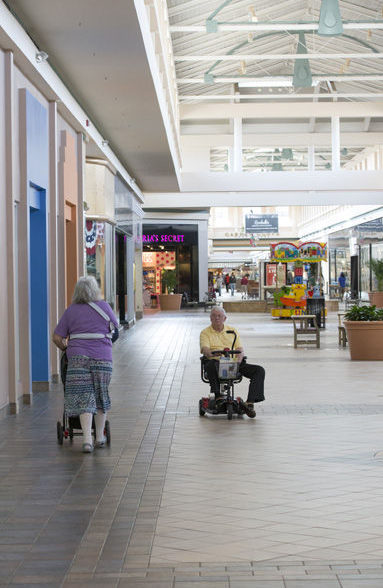
I did something last week I hadn’t done since December. I went to the mall.
Not to the movies. Not to the food court, though I was seriously tempted by Chick-fil-A.
Not to buy anything.
I drove out to the Indian River Mall to see exactly what I expected to see – not enough people shopping, and too many vacant spaces where stores are supposed to be.
It was early afternoon, so I missed whatever lunchtime activity there may have been at the food court and most of the matinee movie-going crowd already was inside the 24-screen AMC theater.
But I did spend an hour strolling around the place, scanning the stores, perusing the kiosks and counting the unleased shops.
There were 25 of them – more than one third of the 70-plus spaces available in the enclosed, 737,000-squarefoot shopping center that was built by Edward J. DeBartolo Corp. and opened in 1996 under the ownership of the Simon Property Group, the nation’s largest mall owner.
But even the stores that were there, still open for business, weren’t as busy as they should be in the heart of our tourist season.
So I can’t say I was stunned by last week’s news that Wells Fargo had foreclosed on the property, which will be put up for auction next week.
The only real surprise would be the bank getting anywhere close to the $71.3 million Simon owes in unpaid loans and interest.
Not that it’s a bad mall.
Actually, Indian River Mall is quite nice – clean, safe and anchored by four nationally known department stores (Macy’s, Dillard’s, Sears and JC Penney.) The food court offers variety. And the AMC theater brings the latest movies to town.
But it’s still a mall – a mall with not nearly enough high-end stores to draw well-to-do island shoppers across the bridge.
It’s still a mall contending with too much competition from the adjacent Indian River Commons, the Vero Beach Outlets at State Road 60 and Interstate 95, the nearby Wal-Mart and Sam’s Club stores to the east, the resurgent downtown shopping area and, across the lagoon, the shops and boutiques along Ocean Drive.
It’s still a mall struggling to compete with the convenience and low costs offered by the internet, which allows people to shop tax-free without leaving the comfort of their homes, eliminating the need to fight through the traffic mess at the often-congested intersection of 20th Street and 58th Avenue.
It’s still a mall that pays too much for city-generated electricity and serves a community that relies heavily on an annual influx of seasonal visitors to boost the local economy.
I wanted to talk to the mall’s management and tenants about those very real challenges, but mall management refused to take questions and said company policy prohibited me from “bothering” store managers.
So I didn’t.
Instead, after stopping to buy an Auntie Anne’s pretzel for a much-deserved afternoon snack, I drove home and called Penny Chandler, president of the Indian River County Chamber of Commerce.
We talked about the mall’s history, its up and down cycles, its local competition.
Chandler didn’t seem to be overly concerned about the foreclosure, saying she fully expects a buyer to emerge – if not at the auction, then eventually – and keep the mall open.
But she did concede the impact of the internet has been significant.
“There’s no doubt the internet has hurt shopping malls and other brick-and-mortar shopping areas,” Chandler said. “The culture of retail shopping has changed, and the internet has been a big part of it.
“But it’s not just the internet,” she added. “Just as there was a time when mall shopping was very popular, there are now people who enjoy walking down a sidewalk and stopping at different stores along the way – either on a street or in an open-air, town-center-type setting.”
Given the tropical climate here, I wouldn’t look for the roof to be removed from our mall. Nor would I expect any future owner to drastically redesign the building.
My guess is, the mall itself won’t change much, despite the fact that it was built – perhaps a bit prematurely – for a community projected to grow in population well beyond where we are now.
What’s inside the mall, however, must adapt to the changing retail-shopping culture to which Chandler alluded.
But how?
More events and activities, perhaps even live entertainment?
More high-end stores that would set the mall apart from the other shopping centers in the area?
What about an indoor miniature golf course?
I’m just spit-balling here, folks, but it’s obvious the place needs to provide an experience that goes beyond typical mall shopping, movies and a food court.
But what?
What kind of investment will the new owner, who almost certainly will buy the mall for far less than Simon owes the bank, be willing to make?
Would anything that makes sense financially be enough to lure people to the mall in the numbers necessary to turn a profit, or at least break even?
I don’t know.
All I know is what I saw, which was exactly what I expected to see as I drove out to the mall last week – not enough people shopping and too many vacant spaces where stores were supposed to be.
And when our winter residents and seasonal visitors head north in the coming weeks, the mall will become even quieter, showing signs of life only during the lunch hour at the food court and on movie nights.
Truth is, unless there’s a movie I want to see or I get a craving for a Chick-fil-A sandwich and shake, my next trip to the Indian River Mall will be in December, when the place is abuzz with holiday shoppers.
It’s fun then.
But only then.
The rest of the year, it’s just a mall – a nice, clean, safe place where too many of us no longer shop.



